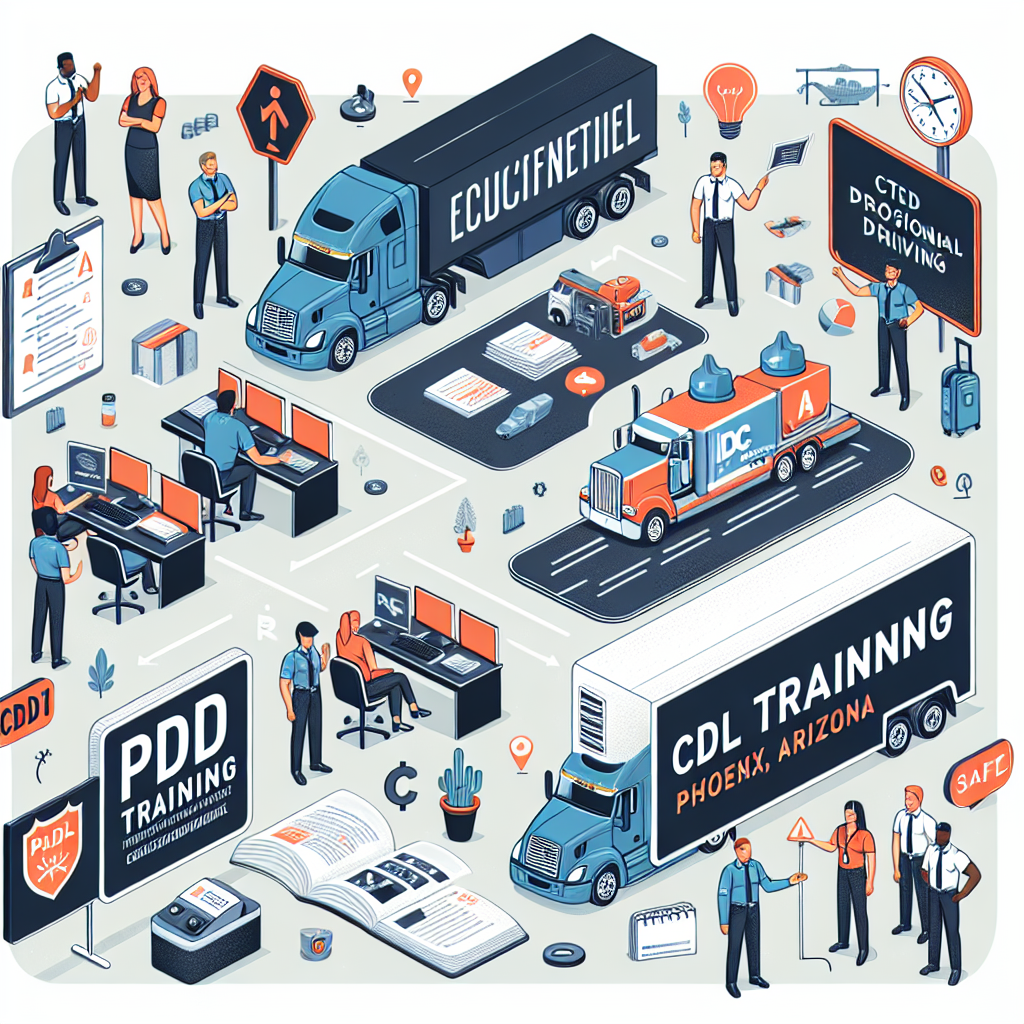Paid Cdl Training Phoenix Az: Latest Trends and Updates is a practical guide for drivers, training providers, and employers navigating the evolving landscape of commercial driver licensing education in the Phoenix metropolitan area. This article summarizes regulatory shifts, training models, technological innovations, and financing options that are shaping how aspiring truck drivers prepare for a commercial driving career.
Current regulatory and industry landscape
Federal standards set by the Federal Motor Carrier Safety Administration (FMCSA) still form the baseline for curriculum and testing, but states and private schools are increasingly adding coursework on electronic logging devices (ELDs), hours-of-service compliance, and drug and alcohol testing protocols. Local workforce demands in Phoenix have pushed many schools to emphasize urban driving, freeway merges, and delivery logistics specific to the desert southwest climate and freight corridors.
Paid CDL courses in Phoenix, AZ — what’s changing
Training providers are experimenting with blended learning: combining classroom lectures, online modules, and hands-on range and road time. This hybrid approach shortens classroom hours for some students while preserving behind-the-wheel instruction, which remains essential for skills like backing, coupling/uncoupling, and maneuvering large rigs in confined spaces. Expect accelerated cohorts and modular certificates aimed at targeted employer needs (e.g., refrigerated freight, flatbed, local delivery).
Key trends shaping programs
- Emphasis on talent pipelines: employers partner with schools to guarantee interviews or conditional hires after successful completion.
- Technology integration: use of telematics, in-cab cameras, and simulator hours to supplement live driving experience.
- Shorter, competency-based paths for experienced drivers converting endorsements (e.g., passenger, tanker).
- Greater focus on safety culture and defensive driving tailored to Phoenix traffic patterns and weather extremes.
Costs, financing, and employer-sponsored models
Tuition for paid CDL training varies widely. Financing options include GI Bill benefits for veterans, Workforce Innovation and Opportunity Act (WIOA) funding through local workforce centers, and employer-sponsored tuition reimbursement or tuition-for-hire contracts. Some carriers offer conditional employment with the schooling covered in exchange for a service commitment; others provide sign-on bonuses after probationary periods. Prospective students should compare net costs after scholarships and job guarantees, not just sticker price.
How to evaluate a program
When choosing a school, look beyond price to completion and placement rates, instructor qualifications, vehicle maintenance standards, and available equipment (manual transmissions, combination trailers). Visit training facilities, ask about road time hours and the ratio of students to tractors, and confirm that the curriculum prepares you for both the CDL skills test and the day-to-day realities of local routes.
Technology and simulation in training
Commercial driving simulators are becoming more common as cost-effective tools for initial exposure to hazardous scenarios without real-world risk. While simulators do not replace live road hours required by licensing authorities, they help students practice complex maneuvers, adverse weather responses, and emergency braking in a controlled setting. Many programs are also using online learning management systems for theory, permitting easier review of safety modules and regulations.
Job outlook and hiring trends
Demand for qualified CDL holders in Phoenix remains strong, with regional warehouses, national carriers, and local delivery firms hiring continuously. For national statistics and occupational outlooks that can help gauge long-term demand and typical wages for heavy and tractor-trailer truck drivers, consult the Bureau of Labor Statistics overview for this occupation, which provides a data-driven complement to local hiring patterns: BLS occupational outlook for heavy and tractor-trailer truck drivers.
Local considerations for Phoenix students
Phoenix trainees should prepare for heat-related vehicle maintenance and safety protocols (cooling systems, tire checks), urban congestion patterns, and the seasonal surge in construction-related detours. Networking with local carriers at job fairs and targeting fleets that operate primarily within Arizona can yield quicker placements and more predictable schedules.
For readers interested in broader, interdisciplinary perspectives on innovation and unconventional thinking—even beyond transportation—see this discussion of theoretical frameworks exploring deep scientific questions: Explorations of Haramein and Planck bridging the universe’s mysteries. While not directly related to CDL training, such resources sometimes inspire creative approaches to problem-solving and systems thinking within technical education.
Quick checklist before enrolling
- Verify school accreditation and state approvals.
- Confirm instructor credentials and vehicle fleet condition.
- Compare total cost after financial aid and any employer agreements.
- Ask about job placement rates and employer partnerships.
- Ensure sufficient hands-on road time and skills testing support.
FAQ
Q: How long does paid CDL training typically take?
A: Programs range from a few weeks for intensive courses to several months for part-time or competency-based paths; accelerated cohorts can finish basic training in 3–5 weeks, but expect additional time for endorsements and job placement.
Q: Can employers pay for my CDL training?
A: Yes—many carriers offer tuition reimbursement or sponsorships in exchange for a work commitment. Always read contracts carefully to understand repayment terms if you leave before the agreed period.
Q: What should I watch for in contracts with schools or carriers?
A: Look for clarity on refunds, job placement guarantees, any service obligations, conditional employment details, and whether the vehicle time meets state licensing requirements.



